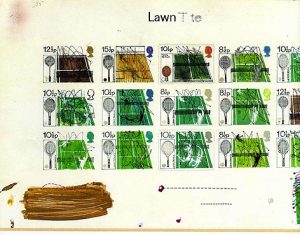Andrew Restall, illustrator
Illustrator Andrew Restall worked from 1964 for the Post Office designing stamps and building on an existing interest in typography and printing processes. From 1975 to 1990 he ran the illustration option of the BA (Hons) Visual Communication course at Brighton Polytechnic.
In 2009 on the occasion of the Brighton College of Art’s 150th anniversary, he wrote:
“From studying drawing and painting at Edinburgh College of Art in the 1940s to living in the Scottish Borders today, my sustaining link has been landscape. Alongside teaching, I worked from 1964 for the Post Office designing stamps and related philatelic material. This took me into a different world, building on an existing interest in typography and printing processes, and developing experience of client liaison. Yet the guiding principles of observation, research, analysis and resolution were the same. In the 1960s I was seconded to the Royal College of Art as Research Fellow in Stamp Design, formulating design policy recommendations and working with students on new ideas.

Andrew Restall, Preliminary designs for racquet sport stamps, 1976
“From 1975 I ran the illustration option of the BA (Hons) Visual Communication course at Brighton Polytechnic for 15 years. Though challenging, this was the most rewarding part of my teaching career. The course had a high reputation for illustration, and I worked with several members of staff who had established reputations for their own work. They were an inspiration to work with and a catalyst for the students. This gave me an opportunity to put into practice a philosophy of self-realisation and encouragement for the students, aimed at helping them find the self-confidence to develop their own, sometimes unexpected, strengths. Some became photographers, designers, or painters, and they often went on to produce a unique body of images and ideas after graduation. Being responsible for the allocation of a personal tutor for each student and for delegating a programme of projects generated a great sense of belonging to a cause. I still have contact with alumni who confirm this view.
“With the development of recognised research in the faculty, I found myself in the demanding role of supervising PhD theses. Then I was perhaps as fraught as the candidates themselves during the external examiner’s visit, but the success of the candidates, notably Dr Evelyn Goldsmith who sadly died earlier this year, gave much reassurance.
“Since retiring as Head of the School of Visual Communication at Edinburgh College of Art, I have been able to concentrate on painting and become involved with printmaking, leading to a one-man exhibition of paintings and works on paper at the Open Eye Gallery in Edinburgh.
“None of the above could have been achieved without the support structures of the faculty, even the committees, that created the feeling of being part of a larger adventure beyond my individual role.”
Andrew Restall 2009
